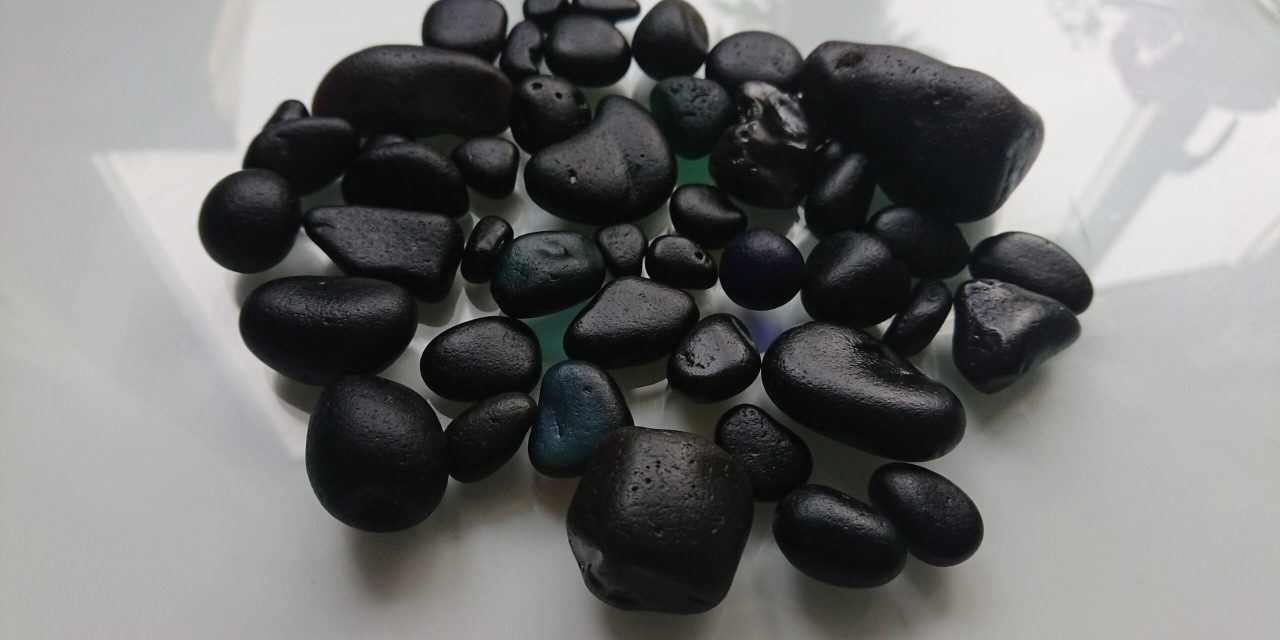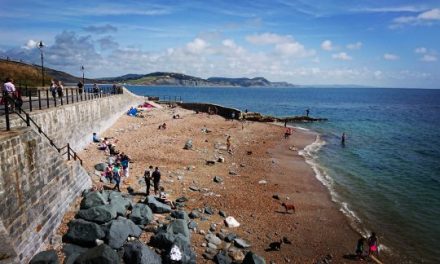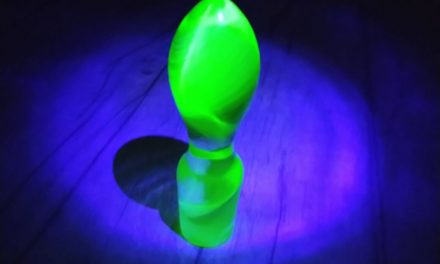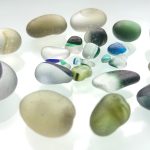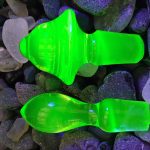Black seaglass
Black sea glass (or as we beachcombers like to call it, pirate glass) is glass that looks black to the naked eye, but once a bright light is shone through it, it shows its true colour. Black sea glass is usually a deep green under the light, but you can find other colours like blue, teal, purple, red, and even brown.
Finding black sea glass can be very difficult because it looks just like any other black pebble on the beach until you shine a bright light through it. Obviously, you can’t shine a light through a pebble, so it’s not hard to tell if it’s a pebble or not once it’s lit up.
Sunlight isn’t concentrated enough to show the true colour of black sea glass, so it has to be done with a direct source of light that shines through it, like a torch, or even the torch on your mobile phone will do it.
What to expect from our article
What is Black Seaglass?
Black sea glass is just like any other sea glass that you will find on the beach, and it comes from the same place as any other sea glass; it just looks different because you cannot see the true colour of it with the naked eye.
Black glass is purposely manufactured that way and is just like every other piece of clear, green, or blue sea glass that is found on the beach, and like them, it comes from some kind of bottle.
Some people believe black sea glass originated from pirates, hence the term “pirate glass”. While it may not be directly from pirates, some of it probably ended up on the beach after being discarded from ships delivering cargo of some kind, so I guess it’s still pirate glass of some sort.
Where does black seaglass come from?
Black sea glass comes from very old black glass bottles. We don’t know how old black glass is, but it could date from as far back as the 16th or 17th centuries. Black glass is historically one of the oldest bottle colours that we know of; it was known as “junk glass” because it was low quality, cheap to make, and mass-produced.
Black glass bottles would have been hand blown, unlike the bottles of today that are machine-made. These days, these old bottles have become very desirable collector’s items, and they can fetch a few quid in their original state.
Why did they use black glass?
The reason for using black glass in bottle making was to protect the contents from degrading when exposed to direct sunlight, which meant the contents would have a longer shelf life. This black glass came in all different shapes and sizes and was primarily used for beer, ale and spirits. It was also used for other things like snuff bottles, ink bottles, mineral water and even some medicine bottles.
Black glass was rarely used for any type of food storage, but the reason for that is not known. In the late 1800s, black glass bottles started to be replaced with other lighter coloured bottles, but there were still companies using black glass bottles (for soda) up until the 1930s.
How did they get different colours of glass?
All glass is made pretty much in the same way, but if you wanted a coloured bottle, you could add specific ingredients into the manufacturing process, resulting in the glass being a different colour.
For example, with blue glass (known as cobalt blue), they added cobalt oxide to the process, making it a beautiful deep blue colour. Adding carbon or nickel would produce brown glass, and adding selenium, copper, or gold would make red glass.
Is Black Seaglass Rare?
Yes, black sea glass is very rare, with blue, red, brown, and purple being the rarest types of black sea glass, so if you do find it, count yourself lucky!
Where can you find black seaglass?
There are beaches where you can still find lots of black sea glass, like Seaham, for example or places that would have seen a lot of traffic back in the day, like beaches next to old harbours. When we visited Seaham Hall beach the other week, we found quite a few small pieces of black sea glass in teal, purple, blue, and green.
It is hard to find black sea glass in Seaham, though, because they just look like all the other pebbles; you definitely do need to have an eye for it. One lady we spoke with at Seaham had told us she hadn’t found any sea glass. She said, “I just kept finding these pebbles.” I noticed as I was talking to her that it wasn’t a pebble she was holding; it was a massive piece of black sea glass.
I said, “Don’t be too disappointed; you actually have a piece in your hand.” She was shocked as she hadn’t heard of black sea glass. I told her to get her phone out and put the camera on. She put the glass over the light, and sure enough, it was bright green. She seemed excited about this and went in search of more.
How do you find black seaglass?
I find the best way to find black sea glass is about an hour or so after the tide has gone out; the glass tends to stay quite shiny, after the pebbles start to dry off, making it stand out more than the pebbles.
If you are in doubt about whether you have a piece or not, get your phone out and shine a light through it to check, or do what I do and just whack it in your bag and hope for the best. I kind of like it to be a surprise when I get home and sort through my finds; it’s like finding treasure all over again.
Like anything else you find on the beach, once you get an eye for finding black sea glass, it is then relatively easy to pick it out. Finding your first piece can sometimes be quite challenging, though, so don’t give up.
How do you find black seaglass?
I find the best way to find black sea glass is about an hour or so after the tide has gone out; the glass tends to stay quite shiny, the pebbles start to dry off, making it stand out more than the pebbles.
If you are in doubt, about whether you have a piece or not, get your phone out and shine a light through it to check, or do what I do and just whack it in your bag and hope for the best. I kind of like it to be a surprise for when I get home and sort through my finds; it’s like finding treasure all over again.
Like anything else you find on the beach, once you get an eye for finding black sea glass, it is then relatively easy to pick it out. Finding your first piece can sometimes be quite challenging, though, so don’t give up.

